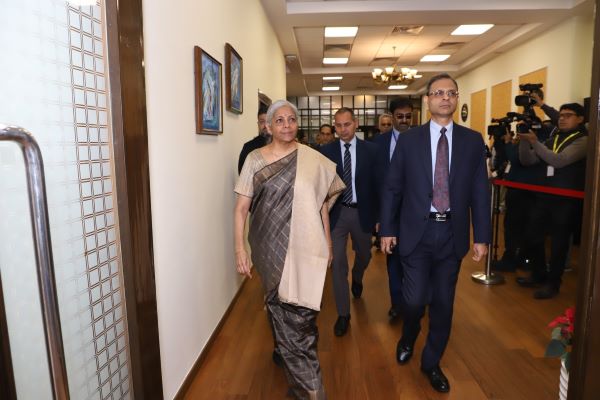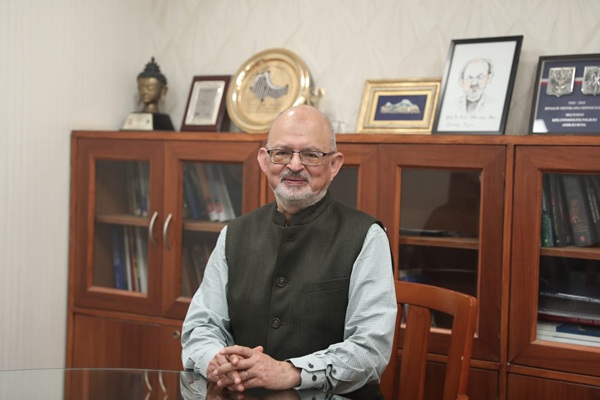.png)
Not All Coins Are Equal: India’s Deliberate March Toward Digital Money
India cautiously explores stablecoins and CBDCs, balancing innovation, programmability, and systemic stability in a rapidly digitalising financial world.


By R. Gurumurthy
Gurumurthy, ex-central banker and a Wharton alum, managed the rupee and forex reserves, government debt and played a key role in drafting India's Financial Stability Reports.
October 10, 2025 at 3:21 AM IST
Finance Minister Nirmala Sitharaman’s recent call for nations to prepare for stablecoin integration signals a fundamental shift in our policy perspective: innovations like stablecoins are reshaping money and capital flows, forcing countries to adapt to new monetary architectures — or risk being left behind. Engagement is no longer optional. Stablecoins have graduated from fintech curiosities to tools of monetary influence, coded diplomacy, and potential geopolitical leverage.
What Exactly Are Stablecoins?
At their core, stablecoins are digital currencies designed to hold value steady, usually by being pegged to fiat currencies like the US dollar. Unlike volatile cryptocurrencies such as Bitcoin, stablecoins aim to combine the technological advantages of blockchain such as speed, programmability, and borderless access, with the predictability of traditional money.
Interestingly, in 2021, IOSCO said stablecoins should be regulated as financial market infrastructures, alongside payment systems and clearing houses.
Issued by private companies as blockchain tokens, stablecoins are typically backed by reserves in cash or highly liquid securities. For example, Circle’s USDC is largely backed by short-term US Treasuries and cash. This collateralisation mechanism enables holders to redeem tokens for underlying assets, preserving stability.
Yet stablecoins are not legal tender, and operate under uneven regulatory oversight. Leading issuers like Tether (USDT), Circle (USDC), and newer entrants like PayPal, are seen as functioning in the grey zone between fintech and shadow banking.
Why Are Stablecoins Rising?
According to McKinsey, the five primary benefits of stablecoins are:
- Speed and availability: Instant settlement, 24/7, unlike legacy payment rails.
- Lower costs: Eliminating intermediaries slashes transfer fees, especially in remittances.
- Transparency and control: Real-time tracking and automated compliance via smart contracts.
- Global access: Wallet-based systems expand inclusion beyond traditional banking.
- Business innovation: Programmable money allows for automated treasury, conditional payments, and tokenised asset settlement.
These features have propelled adoption: global stablecoin market cap has surged from $120 billion to $250 billion in just 18 months, with forecasts of $2 trillion by 2028. Major institutions are embracing it: JPMorgan Chase with JPM Coin, Goldman Sachs and UBS through tokenised cash initiatives, and PayPal with its consumer-facing stablecoin.
Dollar Digitalisation and Geopolitics
The US GENIUS Act of 2025 gave dollar-backed stablecoins a legal framework. But beyond consumer protection, this embeds the dollar deeper into digital finance. By extending extraterritorial reach and codifying programmable rails, Washington is reinforcing dollar dominance and turning stablecoins into digital instruments of power.
If dollar-backed stablecoins dominate global trade, other economies risk their financial arteries being routed through US-controlled systems.
Programmability and the Monetary Policy Dilemma
Programmability is often cited as a key advantage of stablecoins: money that can carry instructions, i.e., releasing payment only on delivery, automatically rebalancing treasuries, or enabling smart contract-driven settlements.
But does programmability raise a deeper issue for central banks: control over money supply? If programmable stablecoins circulate widely, there is a possibility that they can, depending upon the nature, participants, regulations and structure of the stablecoin:
- Bypass the banking system, draining deposits that banks use for lending and credit creation.
- Redirect liquidity flows according to issuer-set rules, not central bank intent.
- Fragment monetary policy transmission, making interest rate changes less effective.
In other words, programmability itself does not create or destroy money, but it can reshape where liquidity sits, and how it moves. If reserves backing stablecoins sit in US Treasuries or offshore assets, domestic liquidity shrinks, blunting policy tools.
This is why central banks, including the RBI, prefer CBDCs and tokenised deposits. These retain programmability’s benefits while staying within the regulatory perimeter. Private programmable stablecoins, by contrast, risk creating a shadow monetary system beyond central bank oversight.
Nobel laureate Jean Tirole has long warned that private stablecoins resemble money-market funds under stress. They can unravel quickly, yet enjoy implicit expectations of government support, without regulatory safeguards. The history of misreported reserves by issuers like Tether validates his concern.
Tirole’s advice is that payments should rest on public infrastructure that aligns with India’s approach. Efficiency is welcome, but not at the cost of systemic stability.
Stablecoins and CBDCs: Complement or Competition?
Globally, so far, stablecoins and CBDCs coexist uneasily. CBDCs carry sovereign backing, but still need systemic trust and acceptability for seamless and efficient functioning. Stablecoins, by contrast, are nimble, private, and adaptable. Some central banks, including the Bank of England, see merit in tokenised deposits or bank-backed digital money, as a safer middle ground.
India’s experimentation may thus encompass all three tracks: CBDCs, tokenised deposits, and private stablecoin observation.
Unlike the dollar, the rupee lacks reserve-currency status. A rupee-backed stablecoin cannot simply be unleashed into global markets. It must be fortified with systemic safeguards: liquidity buffers, legal clarity, and shock-absorption mechanisms.
India’s cautious path – CBDC pilots, sandbox experiments, and strict regulatory oversight – appears to strike the right balance. But eventually, “observation” must yield either adoption or rejection.
But there lies a strategic temptation. Stablecoins could accelerate rupee internationalisation, long a policy goal. Programmable, low-cost rupee settlements for trade and remittances could reduce dollar dependence and expand regional influence.
Rupee internationalisation fits India’s broader economic strategy: reduce dollar dependence, strengthen regional influence, and improve remittance flows. But this requires strong legal frameworks, AML and tax clarity, cyber safeguards, and reserve buffers to absorb shocks. Ambition must be matched by resilience.
Meanwhile, Sitharaman’s call reflects a geopolitical imperative – don’t get left behind while the RBI’s stance reflects prudence: avoid systemic risk. Far from being contradictory, the two are complementary. Ambition without stability is reckless; stability without ambition is stagnation.
India need not succumb to FOMO. Dollar-backed stablecoins may dominate early, but a carefully designed rupee stablecoin, nested in strong public infrastructure, could preserve sovereignty while unlocking innovation. The lesson from Tirole and global experience is clear: public infrastructure first, private innovation second.
Stablecoins may dazzle with efficiency and programmability, but sustainability lies in trusted, transparent, programmable public rails. India must combine ambition with resilience, building frameworks, securing buffers, and integrating legal clarity — before unleashing rupee stablecoins at scale.
In digital money, as in statecraft, strategic patience outperforms reckless haste. The question is not whether India will adopt stablecoins, but whether it will do so on its own terms, or on rails designed elsewhere.



